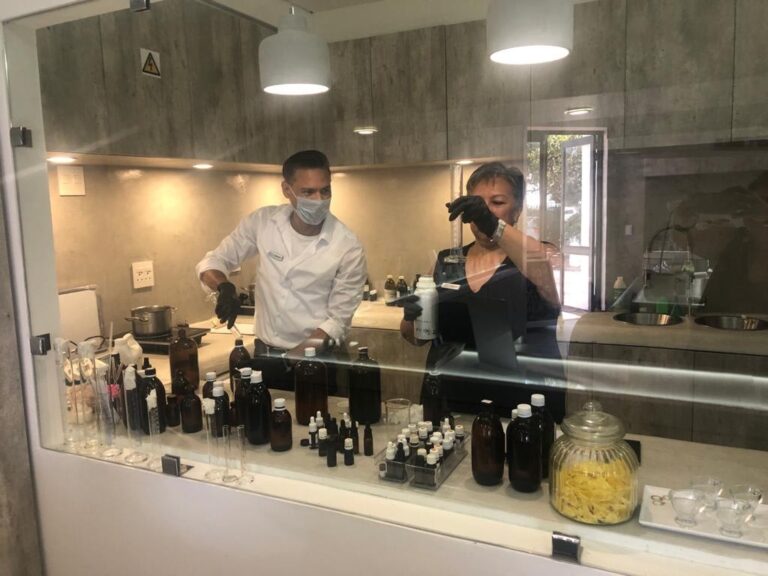This may seem like an absurd question, but the answer is that you actually do! We all know that the skin is the largest organ of the body, but is the fact that our skin readily absorbs many ingredients in skin care preparations always top of mind?
Some sources suggest that women who use lipstick daily may well consume around 2 kilograms of lipstick in their lifetime.
Our skin’s ability to absorb what we apply to it is both good and potentially harmful. Good, because it means that the skin can be nourished from the outside with wonderful ingredients, but when cosmetics contain unsafe
ingredients that are absorbed into the system, this will be harmful.
As we have become much more aware about toxins in our environment, skin care compa-nies are increasingly promoting botanical and organic ingredients for cosmetics. Many are also labelling such cosmetics as botanical.

There is a difference, however, between botanical and organic cosmetics.
A botanical product will usually contain plant based ingredients, e.g. herb oils etc, but it does not mean that the product is entirely safe and non-toxic. An organic product on the other hand, is a product that ought not to contain, or include at any point during its manufacturing process, pesticides, artificial fertilizers or synthetic chemicals. The entire manufacturing process of organic cosmetics is important, from how the plant materials and other ingredients are grown, harvested, stored, transported and eventually pro-cessed and packaged.
“ It is really only when a skin care product is good enough to eat, that it should be good enough to be applied to the skin” Green Spa Guide

Many cosmetics contain emollients, which prevent dryness by acting as a barrier and heal-ing agent; humectants which attract and retain water that keep the skin moist; cleaning agents which are substances capable of dissolving oils so that they can be rinsed away with water; and preservatives. In some ways these ingredients may be bad for the skin when they are of synthetic nature. Let’s look at them in more detail.
Fragrances and colourants are primary ingredients in cosmetics and are largely the reason why these products were created in the first place. Perfumes in particular have ancient origins and were blended using the oils and essences of flowers, plants, tree resins, and spices. The naturally derived fragrances and colourants were replaced in the 19th century with their synthetic counterparts, mainly for economic reasons. In this form, unfortunately, a number of health and transparency concerns arise. Mostly personal care products only list “fragrance” on the ingredient list and not the myriad of chemicals that make up the scent. These chemicals have known skin irritation and up-per respiratory properties. Artificial colourants and dyes are generally created from petroleum by- products or coal tar. The toxic side effects of these ingredients in skincare is a controversial subject and stand accused of causing allergies, skin sensitization and eye irritation, as well as possessing carcinogenic properties.
Synthetic skin care products are also routinely formulated to have a shelf life in excess of three years. This is largely a function of lengthy distribution channels and market behaviour necessitating long turn-around times. In order to achieve such substantial shelf lives, these products often contain large amounts of preservatives to prevent spoilage and they fall in a group of usually four synthetic parabens, which are cellular toxins that penetrate the skin and have been shown to cause allergic reactions and dermatitis. Natural preservatives which are preferable to these parabens include tea tree essential oil or grapefruit seed extract.
Emollients are used in skin care to act as moisturizing agents and to protect and rehydrate dry skin.
Synthetic emollients are occlusive, coating the skin and preventing respiration (much like plas-tic wrap). Apart from causing allergies, many are also not bio-degradable. Natural emollients nourish the skin and are of edible quality.
Many humectants in cosmetic products (included in formulations primarily to retain moisture), are sourced from animals, e.g. collagen and lanolin. They are not necessarily harmless, because the animal may have been dipped or treated with chemical pesticides and the product derived from it may then contain traces of the pesticides. Chemical and synthetic humectants also often form a suffocating film on the skin to prevent moisture loss, whereas a natural ingredient like honey or aloe vera gel attracts water from the surrounding air and holds it where an in-creased level of hydration is needed.
Taking into account all the risks associated with ingredients in skin care products, especially over long term use, spas are increasingly relying on third party certification for natural, organic or sustainable products. Regrettably there is no single, universally accepted set of guidelines yet for labeling cosmetics as natural, organic or sustainable, the terms “certified organic” and “certified natural” are governed by a number of internationally recognized certification bodies. Selecting skin care products with the logo of a certifying body on the label is really the only way of being guaranteed integrity and authenticity in every ingredient.
Bon appétit!

GreenSpa.Africa





